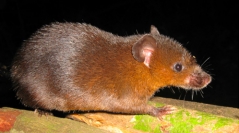

 Zoosystema
47 (27) - Pages 619-689
Zoosystema
47 (27) - Pages 619-689Situated at the border triangle of Liberia, Côte d’Ivoire and Guinea, Mount Nimba provides strong isolation due to climatic and vegetation changes along an altitudinal gradient, which have resulted in high endemism. One of the three tallest mountains in West Africa, Mount Nimba (1752 m a.s.l.) belongs to the Guinean montane forest ecoregion and is situated at the ecotone between the Guinean forest block and the Guinean savanna. Lowland forest extends up to 600 m a.s.l., replaced by montane forest (600-1200 m a.s.l.), and by edaphic altitude savanna (above 1200 m a.s.l.), a very unique biotope and an endemism hotspot. Four field surveys were performed on the Guinean and Liberian sides of Mount Nimba between 2008 and 2013 and in 2017. Live traps were placed at different elevations, in different vegetation zones, and in areas with multiple land uses including protected areas and a variety of anthropogenic habitats. A total of 43 rodent species (32 genera) were collected and identified by an integrative approach combining morphology, morphometrics, cytogenetics and molecular barcoding. Observations of larger, arboreal rodents were also recorded. Edaphic savannas between 500-600 m hosted the highest species richness (11 and 14 species), followed by lowland and montane forests (8-12 species). Some species were restricted to lowland forest, i.e., Malacomys edwardsi Rochebrune, 1885, Dephomys spp., and Typomys trivirgatus Temminck, 1853. Others were recorded in multiple vegetation types up to 1600 m a.s.l. The Mare d’hivernage savanna site (Guinea, 1600 m a.s.l.) hosted eight species but no endemic taxa, with two synanthropic species, Mastomys natalensis (Smith, 1834) and M. erythroleucus Temminck, 1853, in both natural savannas and anthropogenic environments. In Liberia, Rattus rattus (Linnaeus, 1758) was collected in a peri-urban environment in close association with humans. Old collections confirm the presence of several taxa recorded in 1960s and 1970s surveys, i.e., Uranomys ruddi Dollman, 1909, Oenomys ornatus Thomas, 1911, and Mylomys dybowski Pousargues, 1893 (Muridae), two Nesomyidae species and some Sciuridae, Anomaluridae and Graphiuridae. The poor state of some old specimens prevented from confirming the presence of three murids, Arvicanthis cf. rufinus (Temminck, 1853), Praomys daltoni (Thomas, 1892) and Lemniscomys macculus bellieri Van der Straeten, 1975. Our surveys added at least six species, i.e., Mastomys natalensis, Dephomys cf. eburneae Heim de Balsac & Bellier, 1967, Dendromus lachaisei Denys & Aniskine, 2012, Mus baoulei Vermeiren & Verheyen, 1980, Malacomys cansdalei Ansell, 1958, and Cricetomys gambianus Waterhouse, 1840. Such exceptional diversity highlights the importance of the West African highlands as a uniquely important biodiversity hotspot.
West Africa, small mammals, forest, savanna, diversity, montane